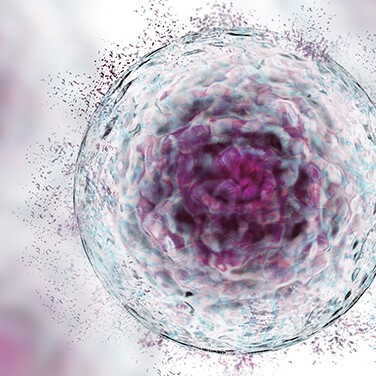Second HIV Patient in Remission After Stem Cell Transplant
By Mike Howie
For the second time, a patient with HIV is in remission after receiving a stem cell transplant. The patient, who was treated by doctors from University College of London and prefers to remain anonymous, has been off medication for 18 months and is still in remission. The doctors caution, however, that it’s too soon to declare that the patient is cured.
The patient received a stem cell transplant to combat a blood cancer, and doctors took the opportunity to simultaneously attack the HIV. They selected a donor with the delta-32 mutation, which leads to specific defective receptors (CCR5) and removes the entryway that HIV uses to attack cells. After the donor cells rebuilt the patient’s immune system, doctors were unable to successfully infect the new cells in the lab using the same HIV. The virus completely disappeared from the patient’s blood after treatment, and 16 months later they stopped taking antiretroviral drugs.
The virus completely disappeared from the patient’s blood after treatment.
10 Years in the Making
The treatment was inspired by a similar transplant in 2009 with Timothy Ray Brown, who came to be known as the Berlin patient when doctors declared him to be the first person cured of HIV. Brown had been living with HIV for years when he was diagnosed with acute myeloid leukemia. When chemotherapy failed to treat the cancer, Brown underwent two stem cell transplants from a donor who had the delta-32 mutation. Brown’s HIV quickly became undetectable after the treatment, and he remains free of the disease to this day.
In the 10 years since Brown was treated and entered remission, doctors tried multiple times to replicate the success. All of those attempts failed, and doctors began to wonder if the case was a fluke. But the newest success in London has reinvigorated interest in therapies targeting CCR5.
The fact that the London patient’s treatment was less aggressive than Brown’s is equally exciting. While Brown received chemotherapy and full-body radiotherapy, the new patient received chemotherapy and a drug that specifically targets cancerous cells. Radiotherapy can have severe side effects that make patients very sick, so removing it from the process makes treatment much easier to bear.
New success in London has reinvigorated interest in therapies targeting CCR5.
Limited Applicability
While exciting and informative, this treatment isn’t appropriate for most people with HIV. It requires a bone marrow transplant, a serious procedure with a variety of risks, including death. It’s far more dangerous than continuing an antiretroviral treatment that requires daily medication, which most HIV patients respond well to.
But for patients who need a bone marrow transplant to treat cancer or another disease, it’s reasonable to seek a donor who has the CCR5 mutation. That in itself could be difficult — only about 1 percent of people of European descent have the mutation — but it doesn’t increase the risk of the procedure.
Researchers are now studying new gene-editing technology in search of a similar treatment that can be applied to more patients with fewer risks. These treatments would use a patient’s own stem cells that are modified to mimic the delta-32 mutation and then returned to the patient’s body. If successful, the new treatment would eliminate the need to find an appropriate donor and the risks of a stem cell transplant — making the process easier for patients and doctors alike.

Read More from Lab Reporter Issue 2, 2019
- Adaptive Fabric Responds to Changes in Body Temperature
- Brain Metabolism Study Reveals Age Differences Between Sexes
- Chemical Accelerators: The Glove-Related Allergen of the 21st Century
- Ductless Fume Hood Safety
- How to Choose the Right Desiccator
- How to Guard Against Cleanroom Contamination
- Microplastics: Investigating Risk and Understanding Evidence
- Protecting n-Butyllithium from Air and Moisture
- Reduce Strain with Ergonomically Certified Gloves
- Safety Compliance: A Team Effort at Texas A&M
- Save Incubator Space with Round Multilayer Devices
- Second HIV Patient in Remission After Stem Cell Transplant
- Solvent Exposure Can Lead to Hearing Loss
- TCI: Innovating to Improve Lab Safety


